Christopher Xie
Human-in-the-Loop Local Corrections of 3D Scene Layouts via Infilling
Mar 14, 2025Abstract:We present a novel human-in-the-loop approach to estimate 3D scene layout that uses human feedback from an egocentric standpoint. We study this approach through introduction of a novel local correction task, where users identify local errors and prompt a model to automatically correct them. Building on SceneScript, a state-of-the-art framework for 3D scene layout estimation that leverages structured language, we propose a solution that structures this problem as "infilling", a task studied in natural language processing. We train a multi-task version of SceneScript that maintains performance on global predictions while significantly improving its local correction ability. We integrate this into a human-in-the-loop system, enabling a user to iteratively refine scene layout estimates via a low-friction "one-click fix'' workflow. Our system enables the final refined layout to diverge from the training distribution, allowing for more accurate modelling of complex layouts.
SceneScript: Reconstructing Scenes With An Autoregressive Structured Language Model
Mar 19, 2024
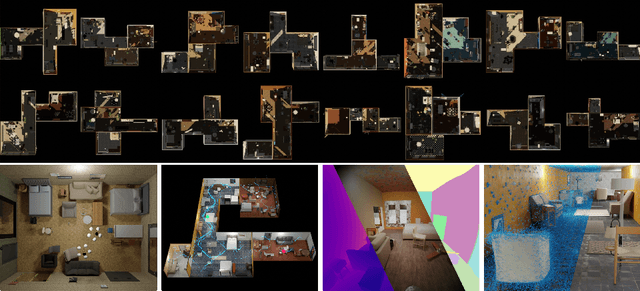

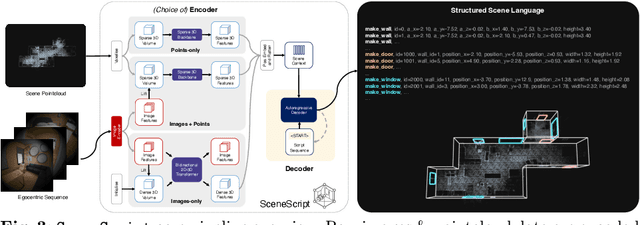
Abstract:We introduce SceneScript, a method that directly produces full scene models as a sequence of structured language commands using an autoregressive, token-based approach. Our proposed scene representation is inspired by recent successes in transformers & LLMs, and departs from more traditional methods which commonly describe scenes as meshes, voxel grids, point clouds or radiance fields. Our method infers the set of structured language commands directly from encoded visual data using a scene language encoder-decoder architecture. To train SceneScript, we generate and release a large-scale synthetic dataset called Aria Synthetic Environments consisting of 100k high-quality in-door scenes, with photorealistic and ground-truth annotated renders of egocentric scene walkthroughs. Our method gives state-of-the art results in architectural layout estimation, and competitive results in 3D object detection. Lastly, we explore an advantage for SceneScript, which is the ability to readily adapt to new commands via simple additions to the structured language, which we illustrate for tasks such as coarse 3D object part reconstruction.
RICE: Refining Instance Masks in Cluttered Environments with Graph Neural Networks
Jun 29, 2021



Abstract:Segmenting unseen object instances in cluttered environments is an important capability that robots need when functioning in unstructured environments. While previous methods have exhibited promising results, they still tend to provide incorrect results in highly cluttered scenes. We postulate that a network architecture that encodes relations between objects at a high-level can be beneficial. Thus, in this work, we propose a novel framework that refines the output of such methods by utilizing a graph-based representation of instance masks. We train deep networks capable of sampling smart perturbations to the segmentations, and a graph neural network, which can encode relations between objects, to evaluate the perturbed segmentations. Our proposed method is orthogonal to previous works and achieves state-of-the-art performance when combined with them. We demonstrate an application that uses uncertainty estimates generated by our method to guide a manipulator, leading to efficient understanding of cluttered scenes. Code, models, and video can be found at https://github.com/chrisdxie/rice .
FiG-NeRF: Figure-Ground Neural Radiance Fields for 3D Object Category Modelling
Apr 17, 2021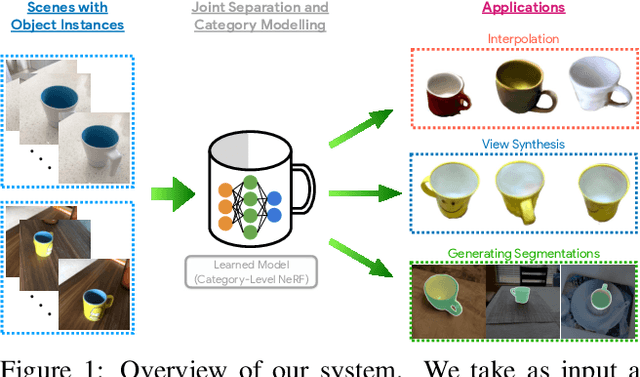

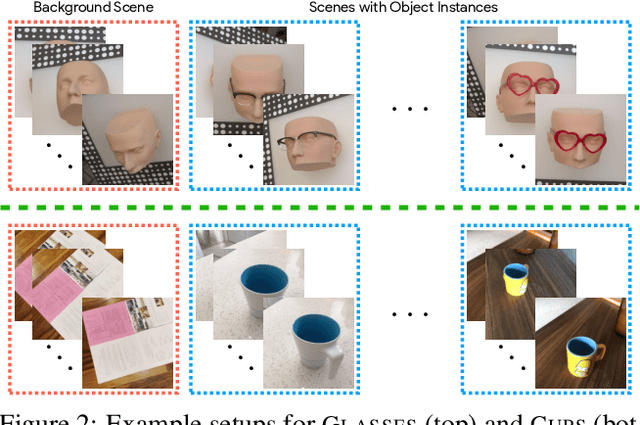
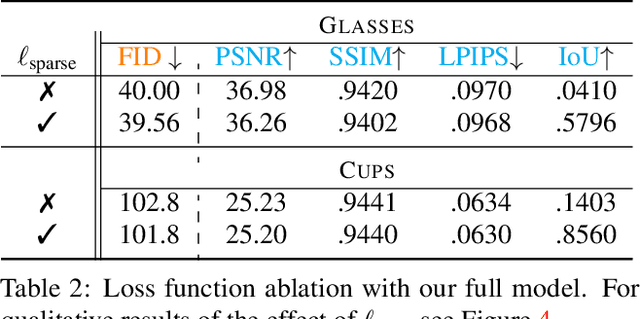
Abstract:We investigate the use of Neural Radiance Fields (NeRF) to learn high quality 3D object category models from collections of input images. In contrast to previous work, we are able to do this whilst simultaneously separating foreground objects from their varying backgrounds. We achieve this via a 2-component NeRF model, FiG-NeRF, that prefers explanation of the scene as a geometrically constant background and a deformable foreground that represents the object category. We show that this method can learn accurate 3D object category models using only photometric supervision and casually captured images of the objects. Additionally, our 2-part decomposition allows the model to perform accurate and crisp amodal segmentation. We quantitatively evaluate our method with view synthesis and image fidelity metrics, using synthetic, lab-captured, and in-the-wild data. Our results demonstrate convincing 3D object category modelling that exceed the performance of existing methods.
Amodal 3D Reconstruction for Robotic Manipulation via Stability and Connectivity
Sep 28, 2020



Abstract:Learning-based 3D object reconstruction enables single- or few-shot estimation of 3D object models. For robotics, this holds the potential to allow model-based methods to rapidly adapt to novel objects and scenes. Existing 3D reconstruction techniques optimize for visual reconstruction fidelity, typically measured by chamfer distance or voxel IOU. We find that when applied to realistic, cluttered robotics environments, these systems produce reconstructions with low physical realism, resulting in poor task performance when used for model-based control. We propose ARM, an amodal 3D reconstruction system that introduces (1) a stability prior over object shapes, (2) a connectivity prior, and (3) a multi-channel input representation that allows for reasoning over relationships between groups of objects. By using these priors over the physical properties of objects, our system improves reconstruction quality not just by standard visual metrics, but also performance of model-based control on a variety of robotics manipulation tasks in challenging, cluttered environments. Code is available at github.com/wagnew3/ARM.
Learning RGB-D Feature Embeddings for Unseen Object Instance Segmentation
Jul 30, 2020



Abstract:Segmenting unseen objects in cluttered scenes is an important skill that robots need to acquire in order to perform tasks in new environments. In this work, we propose a new method for unseen object instance segmentation by learning RGB-D feature embeddings from synthetic data. A metric learning loss function is utilized to learn to produce pixel-wise feature embeddings such that pixels from the same object are close to each other and pixels from different objects are separated in the embedding space. With the learned feature embeddings, a mean shift clustering algorithm can be applied to discover and segment unseen objects. We further improve the segmentation accuracy with a new two-stage clustering algorithm. Our method demonstrates that non-photorealistic synthetic RGB and depth images can be used to learn feature embeddings that transfer well to real-world images for unseen object instance segmentation.
Unseen Object Instance Segmentation for Robotic Environments
Jul 16, 2020



Abstract:In order to function in unstructured environments, robots need the ability to recognize unseen objects. We take a step in this direction by tackling the problem of segmenting unseen object instances in tabletop environments. However, the type of large-scale real-world dataset required for this task typically does not exist for most robotic settings, which motivates the use of synthetic data. Our proposed method, UOIS-Net, separately leverages synthetic RGB and synthetic depth for unseen object instance segmentation. UOIS-Net is comprised of two stages: first, it operates only on depth to produce object instance center votes in 2D or 3D and assembles them into rough initial masks. Secondly, these initial masks are refined using RGB. Surprisingly, our framework is able to learn from synthetic RGB-D data where the RGB is non-photorealistic. To train our method, we introduce a large-scale synthetic dataset of random objects on tabletops. We show that our method can produce sharp and accurate segmentation masks, outperforming state-of-the-art methods on unseen object instance segmentation. We also show that our method can segment unseen objects for robot grasping.
The Best of Both Modes: Separately Leveraging RGB and Depth for Unseen Object Instance Segmentation
Jul 30, 2019



Abstract:In order to function in unstructured environments, robots need the ability to recognize unseen novel objects. We take a step in this direction by tackling the problem of segmenting unseen object instances in tabletop environments. However, the type of large-scale real-world dataset required for this task typically does not exist for most robotic settings, which motivates the use of synthetic data. We propose a novel method that separately leverages synthetic RGB and synthetic depth for unseen object instance segmentation. Our method is comprised of two stages where the first stage operates only on depth to produce rough initial masks, and the second stage refines these masks with RGB. Surprisingly, our framework is able to learn from synthetic RGB-D data where the RGB is non-photorealistic. To train our method, we introduce a large-scale synthetic dataset of random objects on tabletops. We show that our method, trained on this dataset, can produce sharp and accurate masks, outperforming state-of-the-art methods on unseen object instance segmentation. We also show that our method can segment unseen objects for robot grasping. Code, models and video can be found at https://rse-lab.cs.washington.edu/projects/unseen-object-instance-segmentation/.
Object Discovery in Videos as Foreground Motion Clustering
Dec 06, 2018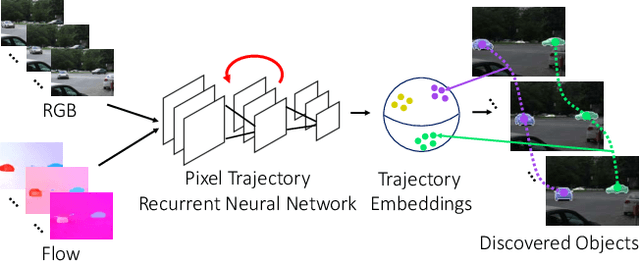

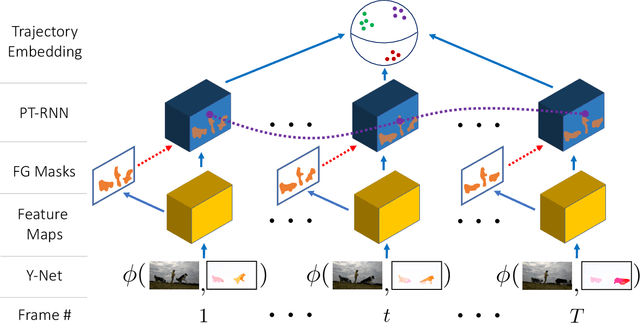
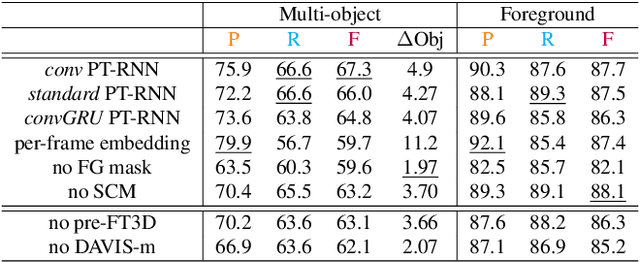
Abstract:We consider the problem of providing dense segmentation masks for object discovery in videos. We formulate the object discovery problem as foreground motion clustering, where the goal is to cluster foreground pixels in videos into different objects. We introduce a novel pixel-trajectory recurrent neural network that learns feature embeddings of foreground pixel trajectories linked in time. By clustering the pixel trajectories using the learned feature embeddings, our method establishes correspondences between foreground object masks across video frames. To demonstrate the effectiveness of our framework for object discovery, we conduct experiments on commonly used datasets for motion segmentation, where we achieve state-of-the-art performance.
A Unified Framework for Long Range and Cold Start Forecasting of Seasonal Profiles in Time Series
Aug 26, 2018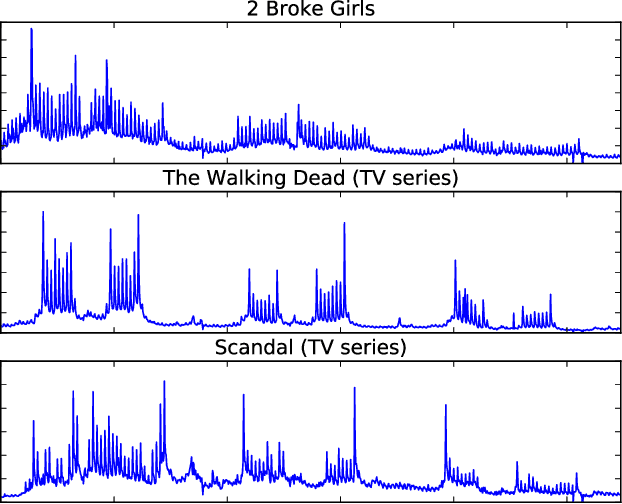
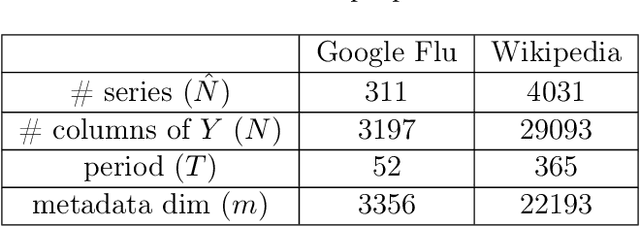


Abstract:Providing long-range forecasts is a fundamental challenge in time series modeling, which is only compounded by the challenge of having to form such forecasts when a time series has never previously been observed. The latter challenge is the time series version of the cold-start problem seen in recommender systems which, to our knowledge, has not been addressed in previous work. A similar problem occurs when a long range forecast is required after only observing a small number of time points --- a warm start forecast. With these aims in mind, we focus on forecasting seasonal profiles---or baseline demand---for periods on the order of a year in three cases: the long range case with multiple previously observed seasonal profiles, the cold start case with no previous observed seasonal profiles, and the warm start case with only a single partially observed profile. Classical time series approaches that perform iterated step-ahead forecasts based on previous observations struggle to provide accurate long range predictions; in settings with little to no observed data, such approaches are simply not applicable. Instead, we present a straightforward framework which combines ideas from high-dimensional regression and matrix factorization on a carefully constructed data matrix. Key to our formulation and resulting performance is leveraging (1) repeated patterns over fixed periods of time and across series, and (2) metadata associated with the individual series; without this additional data, the cold-start/warm-start problems are nearly impossible to solve. We demonstrate that our framework can accurately forecast an array of seasonal profiles on multiple large scale datasets.
 Add to Chrome
Add to Chrome Add to Firefox
Add to Firefox Add to Edge
Add to Edge